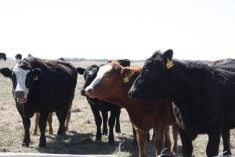This cattle market information is selected from the weekly report from Canfax, a division of the Canadian Cattlemen’s Association. More market information, analysis and statistics are available by becoming a Canfax subscriber by calling 403-275-5110 or at www.canfax.ca.
Feedlots challenge packers
After a $6-$7 per hundredweight early week U.S. fed price rally last week, expectations were high for the Canadian fed market. Feedlot asking prices began aggressively at $275 per cwt. delivered, and significantly outpaced packer bids.
Read Also

Flax sector sees omega-3 opportunity
SASKATOON — A global shortage of omega-3 oils could be an opportunity for the flax sector, says an industry official….
Dressed heifer sales were reported $7-$8 per cwt. stronger than rail trade last week at $270 per cwt. delivered.
U.S. buying interest was affected by the American Thanksgiving holiday but an estimated cash to cash fed basis of -$12.88 per cwt. could renew interest.
Canadian fed slaughter for the week ending Nov. 20 surged 17 percent larger than the previous week to 57,153 head and was 20 percent larger than the five-year average. Western Canadian fed slaughter for the same week was reported 24 percent larger than the previous week and 20 percent larger than the five-year average, totalling 46,439 head. Year to date Canadian fed slaughter was nine percent larger than year ago, totalling 2,507,713 head.
Canadian fed cattle/cow exports to the U.S. for the week ending Nov. 13 were six percent larger than the previous week at 12,283 head.
In the Ontario fed market, packers maintained bids at $270 per cwt. delivered. Feedlot managers dug in to break through price resistance and few cattle were traded.
Feedlot managers were not motivated sellers last week and most cattle were carried over. A softer Canadian dollar and a weak cash basis should encourage U.S. buying interest.
As for the U.S., early week trade developed ahead of Thanksgiving with live prices US$2-$7 per cwt. higher than the previous week in most feeding areas. The bulk of live sales were reported at $135-$140 per cwt.
Weekly weighted average Texas live prices were expected to average around $138 per cwt. this week, which would be the highest seen since May 2017. Northern dressed sales were $7-$9 per cwt. higher than the previous week’s Nebraska rail average, with most trade from $216-$219 per cwt. delivered.
Cow prices up slightly
D2 cows have gained $7 per cwt. in recent weeks, going from the low $60s to the mid or upper $60s per cwt. With a larger flush of cows in early November, non-fed supplies have started to moderate. Given tight feed stocks across the Prairies and producers culling harder than normal, the movement of cows off ranches was not very orderly this year.
Cow-calf producers are becoming more current in marketings, suggesting tighter non-fed supplies are ahead. That should pave the way for higher prices in coming months.
Over the previous three weeks, slaughter cattle exports (fed cattle and cows) to the U.S. are up 4,300 head versus last year. With Alberta cow prices trading at a sizable discount to the U.S., the year over year increase in slaughter exports might be mostly cows.
Western Canadian cow slaughter over the past four weeks has averaged 7,130 head per week compared to 8,504 in 2019 and 9,028 head per week in 2018.
Eastern Canadian D2 cow prices traded $1.25 per cwt. lower for the week ending Nov. 20. Cow slaughter totalled more than 2,800 head, near the largest weekly slaughter levels since December 2018.
Preconditioning pays a premium
More preconditioned calves and feeders have hit the market in the last two weeks. On lightweight calves, there is little to no price difference between preconditioned and freshly weaned. In heavier weight classes, over 700 pounds, there are premiums being paid for preconditioned animals.
On a cash-to-cash basis, Alberta calf/feeder prices are trading at a $8-$11 per cwt. discount against the U.S. market, the largest discount seen this year. In 2020, fourth quarter imports of U.S. feeder cattle totalled 96,000 head. With western Canadian prices at a discount U.S. import volumes are expected to be well below year-ago levels.
Ontario has a sizable cost of gain advantage over Western Canada. Ontario spot corn prices are around $285 per tonne, while Alberta is paying closer to $400 per tonne delivered. That is part of the reason why Manitoba calves are trading at a $2-$6 per cwt. premium over the Alberta and Saskatchewan market.
U.S. cutout rises
In U.S. beef trade, cutout values were steady to modestly higher. Choice was almost US$3 per cwt. higher on improved holiday demand, averaging $279.11 per cwt. on Nov. 24. Select averaged $263.47.














